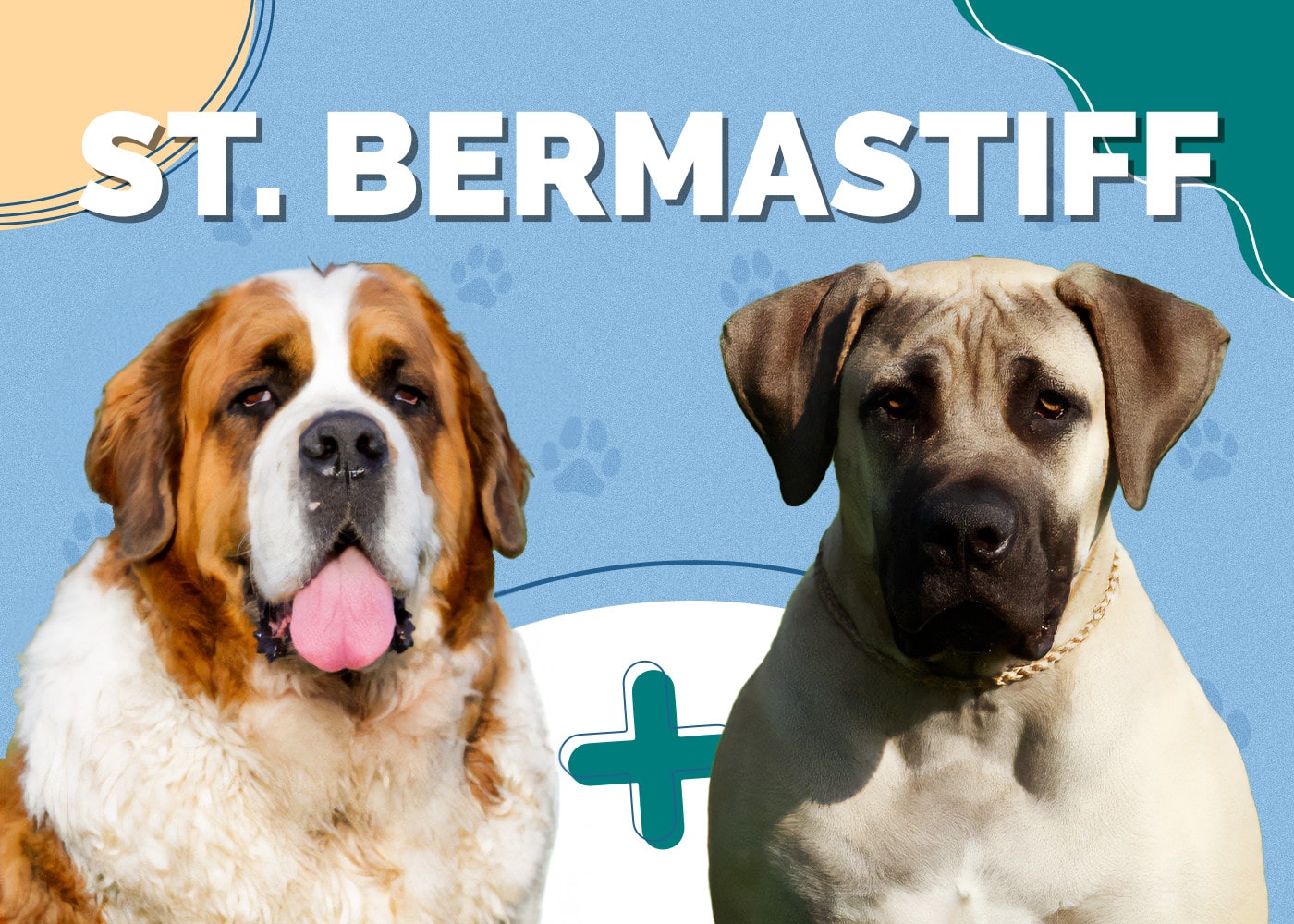Saint Bermastiff (Mastiff & St. Bernard Mix): Pictures, Info, Traits & Care Guide
Updated on

If you’ve always dreamed of having a giant dog that’s more of a teddy bear than a ferocious descendant of wolves, the Saint Bermastiff might be exactly what you’re looking for. These extra-large dogs are gentle giants with extremely affectionate and loyal personalities. If we’ve piqued your interest, you will want to keep reading. We will review everything you’ve ever needed to know about the Saint Bermastiff to determine if it is the right breed for your family.
Breed Overview
| Height: | 22–24 inches |
| Weight: | 150–200+ pounds |
| Lifespan: | 8–10 years |
| Colors: | Black, tan, brown, blue, gray, orange, white, mahogany, red |
| Suitable for: | Experienced dog owners, families with older children, homes with plenty of space |
| Temperament: | Affectionate, easygoing, loyal, lazy |
The Saint Bermastiff combines many of the best qualities of the parent breeds: the Mastiff and St. Bernard. This giant dog breed may look intimidating, but they have huge hearts and protective, affectionate personalities. However, it’s not all sunshine and rainbows. This breed can exhibit signs of stubbornness and may not be suitable for all dog owners, especially those without much experience.
Saint Bermastiff Breed Characteristics
Saint Bermastiff Breed Puppies
If you have your heart set on adopting a Saint Bermastiff, there are some things you need to know first. Since this is a hybrid breed, they can be extremely difficult to find, especially if you’re looking to adopt one in puppyhood. Additionally, we don’t recommend using the first breeder you come across, either. Finding the perfect breeder will take time and patience, and since so many backyard breeders churn out sick and poor-quality dogs, you need to do your research. Reputable breeders should be able to provide health certificates and proof of genetic testing.
Once you’ve found the perfect Saint Bermastiff breeder, you should know what you’re getting yourself into. These puppies are very friendly, lovable, and energetic, though their energy levels will lessen as they grow. Training and socialization from an early age are very important to ensure unwanted behaviors don’t develop.

Temperament & Intelligence of the Saint Bermastiff
The Saint Bermastiff will inherit behavioral traits from both parent breeds. This is generally an easygoing and affectionate dog with a strong desire to please. They tend to be a bit lazy, never turning down a chance to rest and have a nap, though that’s not to say they don’t enjoy going for walks or burning off energy at the dog park.
The sheer size of the Saint Bermastiff will make it a fantastic guard dog. Pair their imposing size with their deep barks and naturally protective nature, and you have a perfect watchdog to look over your family and property.
These sweet dogs love to spend time with the humans in their lives. They’re quite intelligent and easy to train, though they may be headstrong. This is why we wouldn’t recommend this breed for a first-time dog owner. They need someone with experience in training to ensure they grow up to be a well-behaved and well-rounded adult.
Are These Dogs Good for Families? 👪
Despite their giant size, Saint Bermastiffs are generally very gentle dogs. They’re very protective and loyal to their humans, making them a great breed for families. Additionally, their high level of patience makes them a dream for families that have children. However, their size may make them unsuitable for households with particularly young children. While they’re very mellow and laidback for the most part, they can inadvertently hurt young kids if they get excited. Most would never hurt a human on purpose, but they may accidentally knock them over as they go about their day.
Does This Breed Get Along With Other Pets?
The Saint Bermastiff’s ability to get along with other pets can vary from dog to dog. Those who take after their docile and calm St. Bernard parent shouldn’t have too much of a problem living alongside other animals. Mastiffs can get along swimmingly with cats, too, though they can sometimes be naturally territorial and protective.
Regardless of which parent your dog takes after more, proper training and socialization will be key to ensuring your pets live together harmoniously. You’ll also need to take your time with introducing the two animals and may need to keep them separated for some time.
Things to Know When Owning a Saint Bermastiff:
Food & Diet Requirements 🦴
The Saint Bermastiff is a giant dog breed and will require a diet made specifically for their size. It’s also important to consider your dog’s life stage as you choose a diet for them.
Giant puppies need high-energy foods as they expend a lot of energy as they’re always on the move. As you can imagine, large and giant breed puppies grow a lot, but they must grow slowly. Feeding your Saint Bermastiff puppy a diet too high in fat can make them grow faster than their bones can accommodate, potentially resulting in skeletal abnormalities. Food for your puppy should be lower in fat, contain a decent amount of calcium, and provide high-quality protein. According to VCA Animal Hospitals, the best foods for giant puppy breeds should offer around 1.5% calcium, 22% high-quality protein, and 8% fat on a dry matter basis.
The diet for your adult Saint Bermastiff should focus on high-quality animal protein sources to maintain muscle tone, vitamins and minerals to support joints and cartilage, and less fat to keep an ideal body weight for less joint stress.
Exercise 🐕
Though Saint Bermastiffs are not known for their high energy levels, it is still imperative that they get daily exercise. Physical activity is important for maintaining physical and mental health, so expect to take your dog out for walks between 60 and 90 minutes daily.
It’s best to avoid activities that involve too much running or jumping, even when your dog is fully grown. This type of movement can put pressure on their joints and ligaments, which may make them prone to injuries due to their sheer size.
Training 🎾
The parent breeds of the Saint Bermastiff are known for their eagerness to please their owners. Additionally, they’re typically quite intelligent and can pick up commands with ease, provided they’re interested in their training sessions. These dogs are highly motivated by food, so use this to your advantage to see quicker success with training.
The Saint Bermastiff can be quite stubborn, which may make them unsuitable for first-time dog owners.
Grooming ✂️
Your Saint Bermastiff’s coat characteristics will depend upon which parent breed is most dominant.
If your dog takes after the Saint Bernard side more, they may be either short or long-haired. The shorthaired coat is smooth, dense, and slightly bushy in the thigh region. The longer coat is slightly wavy, with some feathering on the forelegs.
If your pup takes after the Mastiff side, they’ll sport a short, coarse coat.
Regardless, you should expect to brush your dog a few times per week to keep their coat looking its best. Neither parent breed requires frequent baths as over-bathing can strip their coat of its natural oils and cause dry or irritated skin. A bath every two to three months should be sufficient. Both parent breeds have droopy ears, which may be prone to infection if not cleaned properly or regularly.
Health and Conditions 🏥
While Saint Bermastiffs are generally healthy, they may be predisposed to the same health conditions as their parent breeds.
Like all giant breeds, the Saint Bermastiff will sadly have a shorter lifespan than its small and medium-sized counterparts.
- Entropion
- Ectropion
- Cancer
- Hip dysplasia
- Degenerative myelopathy
- Epilepsy
- Gastric dilatation and volvulus
- Osteosarcoma
- Lymphoma
Male vs Female
The most notable difference between the male and female Saint Bermastiff is the size. As with most dog breeds, males are generally larger in size and weight. No research suggests personality traits are specific to gender, though you may read otherwise in anecdotal claims by current owners.
3 Little-Known Facts About the Saint Bermastiff
1. Saint Bermastiffs are among one of the largest dog breeds.
It shouldn’t come as too much of a surprise that the Saint Bermastiff is one of the largest dog breeds, considering both parents are extremely large. Male Saint Bernards can weigh up to 180 pounds, while their Mastiff counterparts can weigh as much as 230 pounds!
2. Both parent breeds are very old.
The earliest reports of Saint Bernard’s come from monks in the 1600s who used the dogs to locate and rescue people who became buried in avalanches in the Western Alps in Italy and Switzerland. As for the Mastiff, there are records in Europe and Asia dating back 3,000 years ago showing dogs of the Mastiff type.
3. Both Saint Bernards and Mastiffs are descendants of the Roman Molossian dogs.
Both parent breeds are descendants of the Molossian dogs of Roman times. The Molossus was a dog breed from Ancient Greece, used by the tribes and kingdoms of the Molossians who lived in the region of Epirus, an area of Europe now shared between Greece and Albania. The Molossus were famous for their size and ferocity and are mentioned in many types of ancient literature, including in the writings of Aristotle and Aristophanes.
Final Thoughts
Saint Bermastiff are gentle giants and protective and loyal family dogs. They are one of the largest hybrid breeds, so that is something all potential owners must consider, especially if they live in an apartment or smaller home. These dogs can weigh up to 200 pounds or more, so they need a lot of space. Additionally, their size is important to consider if you have small children in the home. While they generally wouldn’t ever harm a child on purpose, their huge bodies can inadvertently inflict damage.
Saint Bermastiff owners must be willing to socialize and train their puppies from the get-go. While neither parent breed is known for aggressiveness, the last thing you’ll want to contend with is a 230-pound dog that doesn’t respect you. This is why we do not recommend this breed for first-time dog owners. However, if you have experience with large breeds and are searching for an affectionate, loyal, and somewhat lazy dog, the Saint Bermastiff could be it!
Related Article:
Featured Image Credit: Left – Aneta Jungerova, Shutterstock | Right – Olga Aniven, Shutterstock













